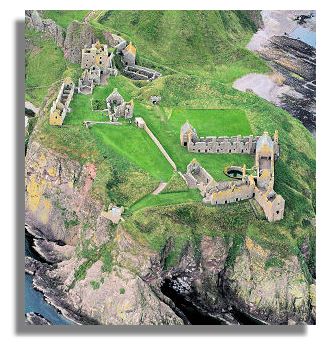
Photos copyright Scotavia Images
Scottish Castles Photo Library
- Dunottar Castle, Aberdeenshire


Location
The ruins of Dunnottar Castle are located 160 feet high on a rocky outcrop on the north-east coast of Aberdeenshire, about two miles south of Stonehaven. It is surrounded by sheer cliffs that drop into the North Sea, with access only via a narrow strip of land adjoining the mainland. There is a steep path leading up to the massive gatehouse. There is also access from the sea via a rocky cove.Today, the A92 coastal road passes by not far from Dunnottar, which is now maintained by Historic Scotland.
Early Years
There is a record of a siege of "Dún Fother" in 681 and there was also a battle there between King Donald II and Viking raiders in 900. Then, in 934, King Aethelstan of Wessex attacked on Dunnottar.William Wallace is said to have led the Scots to victory over the English at Dunnottar in 1296. The captured English soldiers were locked into the castle church - and burned to death, possibly as retaliation for a massacre of Scottish civilians in the Borders. In 1336, King Edward II of England sent an invading force to Dunnottar to create a forward supply base - but Andrew Murray captured and destroyed the defences.
The Keiths, who were the made Hereditary Great Marischal (in charge of the cavalry) by Robert the Bruce, acquired the Dunnottar Castle in 1382. The 9th Earl led the Jacobite cavalry at the Battle of Sheriffmuir in 1715 and the Keiths also supported the 1745 Jacobite Uprising - and forfeited lands, castles and titles as a result.
Later History
In the 16th century, Mary Queen of Scots visited Dunnottar in 1562 and 1564 and her son, King James VI stayed there in 1580. Shortly after that, the Earl Marischals converted a medieval style fortress into an opulent castle, arguably the most luxurious living quarters in Scotland at that time. Further construction took place in the 16th and 17th century - there are 11 buildings still surviving on the promontory of Dunnottar.During the Civil War, Cromwellian forces besieged Dunnottar which was holding the Regalia of Scotland - Crown, sword and sceptre, which had been used to crown Charles II on January 1, 1651. A small garrison withstood the onslaught but eventually were forced to surrender. But by that time the Regalia had been smuggled out of the castle. They were later kept at Edinburgh Castle - and forgotten about until Sir Walter Scott rediscovered them in 1818. The "Honours of Scotland" (and the Stone of Destiny) are now displayed in Edinburgh Castle.
Castle Buildings
With its defensive cliffs and narrow access, Dunnottar did not need the usual castle walls to keep out intruders. Over the years, many individual buildings were constructed; those that survive date from the 13th to 17th centuries.Note
The photos of Dunnottar Castle on this page are copyright Scotavia Images who provide a quality aerial photography service for Scotland. Prints from their large online gallery are available for purchase. If you have ancestors with a Scottish Highland origin, they can provide an aerial view of the area they came from!
Return to the Castles Photo Library Index
or go to the next castle:  Dunrobin Castle.
Dunrobin Castle.
Where else would you like to go in Scotland?
Where else would you like to go in Scotland?

